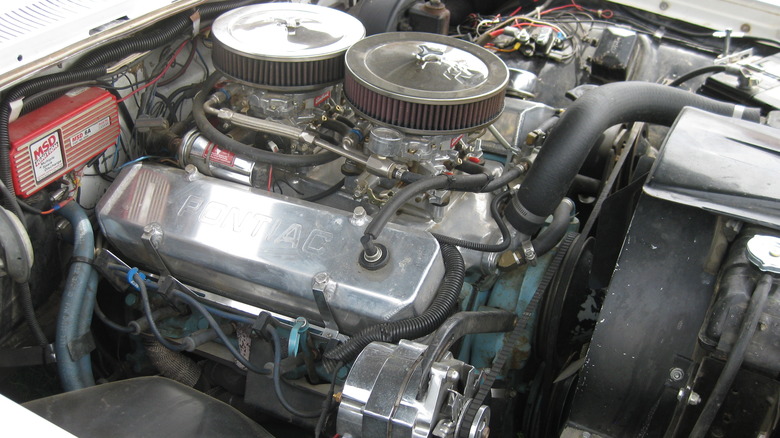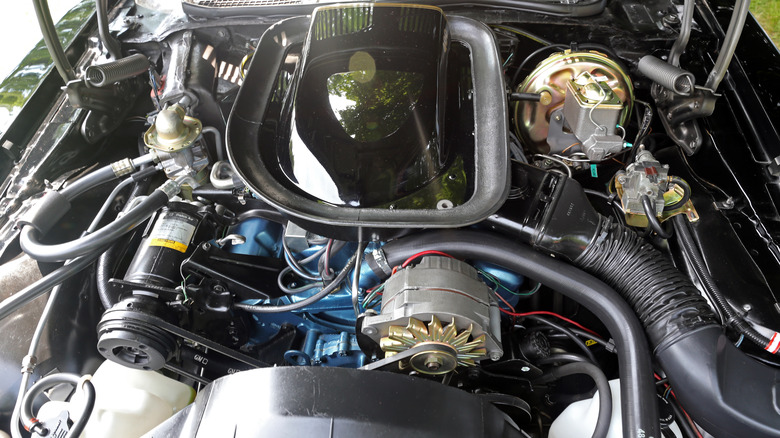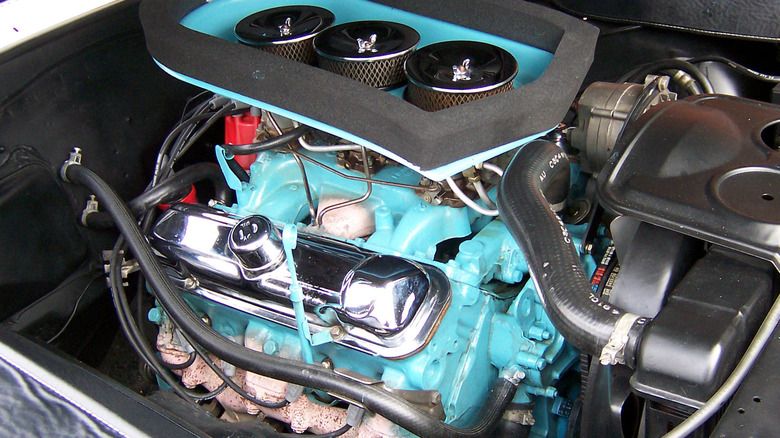Are All Pontiac V8 Engine Blocks The Same? Here's How To Identify Them
The Pontiac division was established by General Motors in 1926 and thrived during the muscle car era, producing memorable models like the era-defining 1964 GTO. Pontiac's market share steadily declined in the waning decades of the 20th Century, leading GM to drop the brand in 2009 as part of a bankruptcy reorganization.
Pontiac's lasting legacy also includes some stunning graphic schemes, as well as a line of potent V8 engines produced from 1955 through 1981. Pontiac first used a V8 in 1932, but that engine was essentially a clone of the engine used by GM's lower-tier Oakland division. It produced just 85 horsepower despite a displacement of 251 cubic inches, and Pontiac went back to a flathead straight-eight format for 1933 and 1934. By the time the mid-'50s rolled around, V8s were powering most of Detroit's most popular cars, like the 1955 Corvette with its 195 horsepower "Turbo-Fire" powerplant. According to industry lore, Pontiac was poised to unveil its updated line of V8 engines in 1953, but chief engineer George Delaney wanted some more time to perfect the new engine. Pontiac's fresh V8 finally went into production for the 1955 model year, with 287 cubic inches of displacement and an output of as much as 180 horsepower.
[Featured image by dave_7 via Wikimedia Commons|Cropped and scaled|CC-By 2.0]
Certain engineering changes can help you pin down your Pontiac V8's year
There are a few visual clues to help you identify when your Pontiac V8 was made, and hunting around for the casting code can help you pin down its displacement. One indicator is the location of the PCV (Positive Crankcase Ventilation) port on the valley pan atop the engine. Through 1966, the port was located in the rear of the valley pan, and from 1967 on, it was moved to the front. Like any other visual test, this is only accurate if the engine has not been modified. The location of the starter can also clue you in to the engine's age. Until 1964, Pontiac mounted the starter motor to the transmission bellhousing, after which it was moved to the engine block on most models (on some larger Pontiacs like Catalinas and Bonnevilles, the change wasn't made until 1965). V8s made in 1965 and 1966 have two freeze plugs on the block, while engines made between 1967 and 1978 have three.
Some Pontiac V8s have the displacement stamped on the block itself. 428 cubic inch V8s made in 1968 and 1969 have a "428" between the freeze plugs, and some engines after 1970 have their displacement numbers on the driver's side near the front of the block. This applies to 350,400, and 455 cubic inch engines only. 326, 389, and 421 inch engines had no such markings.
[Featured image by Mr. Choppers via Wikimedia Commons|Cropped and scaled|CC-By 3.0]
Casting codes can provide additional information
You can find more clues on the rear of the block, on top near the distributor mounting point. On most Pontiac V8s, you should be able to find a date code and casting number there. The date code is a three-or four-digit sequence that begins with a letter. "A" represents January, "B" February, and so on through "L" for December. The exception is 1967, when Pontiac used "M" for December for some reason. After the month code comes the date the engine was made, either occupying one or two digits. The remainder of the date code indicates the year; a "9" in that final spot indicates a manufacture year of 1959, or '79. Engines made in 1969 and 1970 have a two-digit code to identify their year of manufacture, and the location of the casting code can also be a clue to the year the engine was made.
Through 1963, Pontiac stamped the casting code on the block's passenger side, and from 1964 through 1967 it was placed near the distributor. Between 1968 and 1981 the casting code was stamped on the rear of the block behind the No. 8 cylinder, which means you might have to do some stretching or use a mirror to read it.You can also find cylinder head casting codes between the center exhaust ports, and the head date codes are just to the right of the head casting codes. You can also use a VIN decoder to identify the engine on your classic Pontiac.
[Featured image by Morven via Wikimedia Commons|Cropped and scaled|CC-By 3.0]


